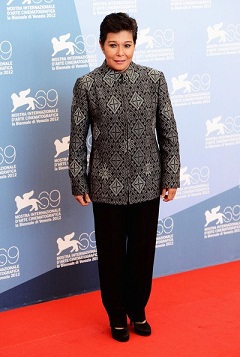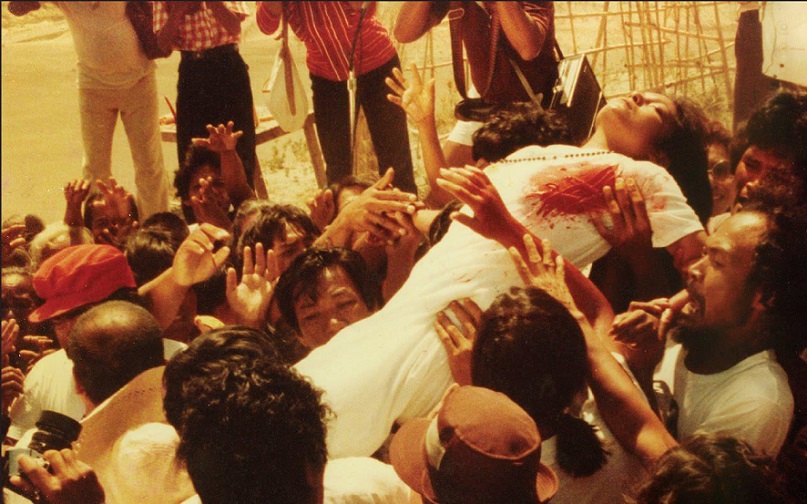 MANY of Nora Aunor’s past films are virtual cases of art imitating the actress’s poignant, sad, and by turns, happy life.
MANY of Nora Aunor’s past films are virtual cases of art imitating the actress’s poignant, sad, and by turns, happy life.
To be sure, a few of her past films come to mind when an independent group of Italian film critics covering the 69th Venice International Film Festival gave her the Bisata d’Oro (Golden Eel) for best actress for the Brillante Mendoza film, “Thy Womb.”
Her Bisata d’Oro citation reads thus: “Her class and intelligence as an actress lights up her performance with the necessary and important emotion. Nora Aunor shows that the work of an actress is to communicate ideas with intense expression and to make them credible…”
Indeed it was nothing short of “Himala” (miracle) because she was singled out from the 16 other lead actresses in 16 other competing films in the festival.
“Himala” was the title of her 1981 Ishmael Bernal film which earned for Aunor her first international best actress nomination in the 1983 Berlin Film Festival.
The miraculous streak of “Himala” lasted for decades because the same 1981 film was the only Filipino film chosen by CNN as one of the ten best Asian films of all time from the provisional list of 18 great films for the year 2008. CNN cited “Himala” for its “austere camera work, haunting score, and accomplished performances that sensitively portray the harsh social and cultural conditions that people in the Third World endure.”
The same film was also awarded the CNN APSA Viewers Choice Award for Best Asia-Pacific Film of all Time in November 14, 2008.
Born Maria Leonora Teresa Cabaltera Aunor on May 21, 1953, Nora had some lucky streaks which were like a scene from her 1972 film, “And God Smiled at Me” where she won another best actress award.
And yet a few years back, she figured in a drug case in an international airport which caused her detention in a US jail.
 Like it or not, her real life abroad became a virtual scene from her 1984 film, “Bulaklak ng City Jail” where she played the role of an inmate which earned her another best actress award.
Like it or not, her real life abroad became a virtual scene from her 1984 film, “Bulaklak ng City Jail” where she played the role of an inmate which earned her another best actress award.
In 2001 during another reprise of an EDSA upheaval, she admitted on national television a relationship with a former president who she said beat her during several of their lovers’ altercations. Like it or not, that life was like a scene from her film, “Bona” the theater version of which she watched starring the new Bona of Eugene Domingo.
In the 60s, she caught the national attention when she won several amateur singing competitions. All of a sudden, a botched operation affected her vocal chords and she woke up one day with her golden voice gone. To this date, an earlier scheduled throat operation in Boston didn’t revive that singing voice.
For the record, that same voice broke sales record for Philippine recordings which up to this date, according to Noranians, have yet to be surpassed. She has recorded more than 500 songs among them “Pearly Shells” (1971) which is one of the country’s biggest hits with more than one million units sold. Last year, she was considered as one of the country’s OPM (Original Pilipino Music) Icons.
With that voice now suddenly gone, she went through an empty phase virtually like a scene from her 1976 film, “Tatlong Taong Walang Diyos” (Three Years Without God) where she garnered another best actress trophy.
When she returned last year for a role in a TV station’s teleserye, “Sa Ngalan Ng Ina”, (In the name of the Mother) she came up with another winning performance under a watchful eye of her mentor, Mario O’Hara who passed away this year. But that teleserye folded up too soon. She was left with only one career choice left: film acting.
The red carpet premiere of “Sa Ngalan Ng Ina” brought back memories of her colorful past.
For one, her fans were back and they shrieked no end at the sight of their idol, applauded every scene where she delivered with aplomb and they stood by her even after the screening and during the presscon conducted right inside the theater.
 Her fans have a special place in her heart.” My fans are no longer what they used to be but they remain loyal,” she said then. “There are those who simply got married, had children but when my name is mentioned, they still remember.”
Her fans have a special place in her heart.” My fans are no longer what they used to be but they remain loyal,” she said then. “There are those who simply got married, had children but when my name is mentioned, they still remember.”
Nora was a movie fan herself and she knew the unpredictability of one. She was a rabid Amalia Fuentes follower but when she was ignored while she was asking for an autograph, she switched to the Susan Roces camp. “I have no regrets because I found out ang bait-bait pala ni Susan Roces. When I guested in her film ‘Pangarap Ko’y Ikaw,’ the more I realized Susan was good-natured even off camera. That’s the reason I see myself in my fans.”
When her reel and real life went through some crisis, she turned to her fans for solace.
When she decided to pull herself from the pit, she turned to her fans for re-assurance.
“A severe crisis can make or unmake you,” she continued. “Even as I was going through one of worst trials, I sought strength from my fans. Pagnakikita ko sila, nagkakaroon ako ng lakas dahil nandoon pa rin ang pagtitiwala nila.(When I see them, I gain strength because their trust is still there.) It is no joke to lose friends as your fortunes dwindled but somehow some of my fans had stayed with me through some of my worst tribulations.
When her ‘70s popular weekly TV show, “Superstar” bowed out from the scene, she turned to theater with a vengeance (“Minsa’y Isang Gamu-Gamu,” “DH,” Cassandra in “Trojan Women”), then she concertized abroad, did one more movie (“Inay”) and suddenly she had resurfaced in hotel lounges as a singer.
One remembered that concert for her stirring version of “The Windmills of My Mind” which she said captured many untold chapters of her life and loves.

